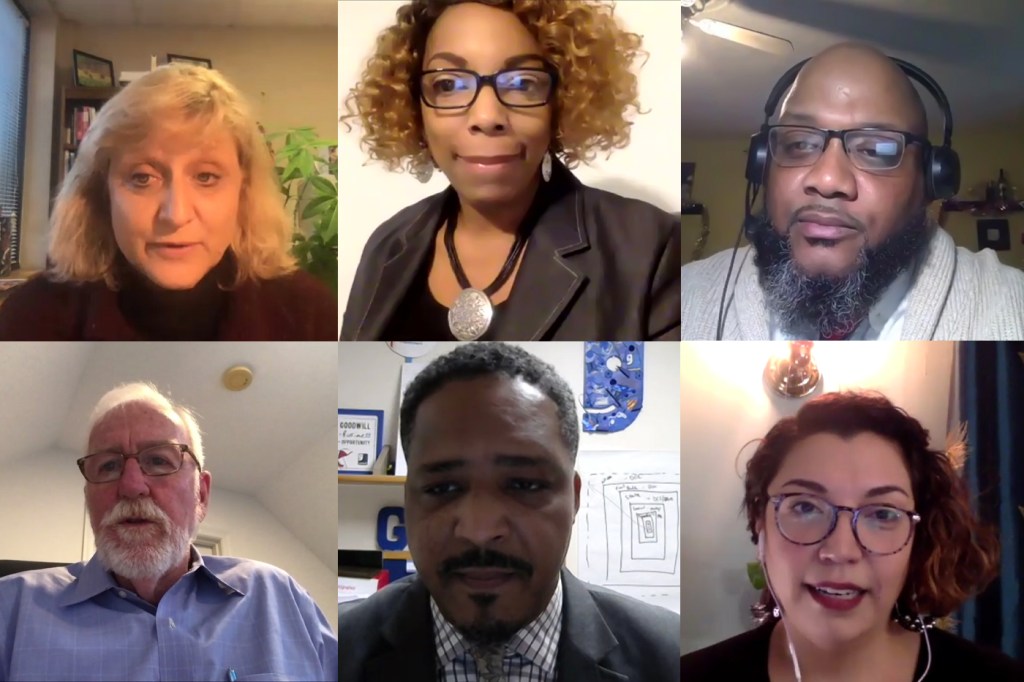Do school police keep students safe, or reinforce the school-to-prison pipeline?

The past 30 years have seen a drive to install school resource officers—essentially, police officers—in public schools. But too little forethought or consideration has been given to how people trained in law enforcement would acclimate to institutions designed to socialize and educate children, said Lisa Thurau, an advocate for improving interactions between police and youth.
As many of these officers have arrived with little knowledge of school protocols or laws protecting youth with special needs, she said, students of color have disproportionately felt the consequences.
Thurau, the founder and executive director of Strategies for Youth, a nonprofit organization that works to reduce contentious encounters between police and youth, shared these findings during a panel discussion hosted by Northeastern University’s Institute on Race and Justice.
Panelists in the virtual discussion homed in on the impacts of school policing, and how inadequate planning and clarity around these programs has led to lawsuits, high rates of student arrests—often for minor offenses that would not have been previously considered criminal—and escalating friction between schools and law enforcement, parents and police, and communities and schools.
Lucinda Mills, a district social worker at Boston Public Schools, pointed out that few law enforcement officers receive training regarding developmental differences, child trauma, and racial equity to guide their interactions with youth.
“A lot of times they ask police to intervene in those types of situations instead of the counselor, the social worker, the school psychologist,” said Mills.
The prevalence of school resource officers coincided with the passing of the Safe and Drug-Free Schools and Communities Act of 1994, at a time when schools were perceived as dangerous places that needed regulation by law enforcement, said Thurau.
This perception was solidified in 1998 with the Columbine shootings, followed by other school shootings. Federal funding for school resource officer programs increased dramatically in the early aughts, and has been climbing since.
While the initial objective was to stop violence and keep young people safe, Thurau said, school resource officer programs have had the adverse effect of pushing officers to use law enforcement responses inside the school.
Systemic factors, such as location, have also led to extreme racial disparities, said Thurau. School resource officers were often placed in urban areas where the students were predominantly poor youth of color, or in school systems that used exclusionary discipline—such as suspension and expulsion—instead of more forgiving and holistic responses.
Thurau said some in law enforcement, unaware of their own racial biases, have been less willing to consider that youth of color have a mental health issue or exhibit behavior that may not reflect intentional wrongdoing.
As a result, she said, youth of color are more likely to be suspected, targeted, and threatened with arrest. They’re also more likely to be disciplined, expelled, and arrested. The psychological toll of this treatment leads to decreased grades, increased anxiety, and lower long-term education prospects, as well as reduced rates for school completion and college attendance.
The funding of school resource officers has also come at the expense of funding for other services for youth, Thurau said.
“As students have less access to support services, more money is being spent on officers to learn basic child and adolescent care skills. And a lot of people are questioning whether or not that is the best quid pro quo for an educational dollar,” Thurau said.
In addition, she says, in some districts, policies that govern what school resource officers can and cannot do on the job are lacking or are not made available to the public, said Thurau.
“We don’t know, for instance, what most school resource officers’ policies are for using restraints,” she said. “We don’t know what their use of force policies are in public schools, or whether or not they should call U.S. Immigration and Customs Enforcement or the Department of Homeland Security. We’re not even sure what their obligation is to notify parents, much less what they’re allowed to access regarding records.”
Questioning whether the presence of police in public schools reinforce the school-to-prison pipeline, Mills called for a re-evaluation of school resource officer programs, at every level—and for more support services, resources, and interventions to help keep all students safe.
“Are [the officers] receiving mental health training?” said Mills. “Are they receiving trauma training? Are they helping to build relationships with students? Are they helping or are they harming our school climate?”
Roxanne Longoria, director of strategic initiatives and partnerships in the Mayor’s Office of Health and Human Services for the city of Boston, said many young people struggle with hidden disabilities, homelessness, and other issues. It is crucial for school resource officers to understand these issues, she said, adding that involving young people in these dialogues and giving them a voice is also important.
“It’s helpful to talk about this with young people themselves and to empower them to share their own story because it’s those stories that really change the minds of adults so that they can understand the bigger picture of what a young person might be going through,” Longoria said.
The conversation around police and youth will continue on Feb. 23 with the next installment of the “Race, Policing and the Community” series, followed by a discussion on April 27 about race and immigration as it intersects with law enforcement.
For media inquiries, please contact media@northeastern.edu.





